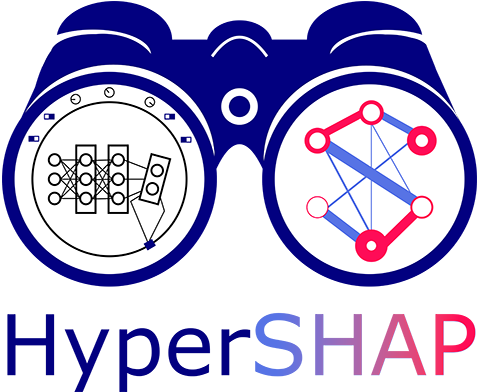HyperSHAP – a game‑theoretic Python library for explaining Hyperparameter Optimization (HPO). It uses Shapley values and interaction indices to provide both local and global insights into how individual hyper‑parameters (and their interactions) affect a model’s performance.
- Github repository: https://github.com/automl/HyperSHAP/
- Documentation https://automl.github.io/HyperSHAP/
- Additive Shapley decomposition of any performance metric across hyper‑parameters.
- Interaction analysis via the Faithful Shapley Interaction Index (FSII).
- Ready‑made explanation tasks for Ablation, Tunability, and Optimizer Bias studies.
- Integrated visualisation (SI‑graph) for interaction effects.
- Works with any surrogate model that follows the
ExplanationTaskinterface.
$ make installGiven an existing setup with a ConfigurationSpace from the ConfigSpace package and black-box function as follows:
from ConfigSpace import ConfigurationSpace, Configuration
# ConfigurationSpace describing the hyperparameter space
cs = ConfigurationSpace()
...
# A black-box function, evaluating ConfigSpace.Configuration objects
def blackbox_function(cfg: Configuration) -> float:
...You can use HyperSHAP as follows:
from hypershap import ExplanationTask, HyperSHAP
# Instantiate HyperSHAP
hypershap = HyperSHAP(ExplanationTask.from_function(config_space=cs,function=blackbox_function))
# Conduct tunability analysis
hypershap.tunability(baseline_config=cs.get_default_configuration())
# Plot results as a Shapley Interaction graph
hypershap.plot_si_graph()The example demonstrates how to:
- Wrap a black-box function in an explanation task.
- Use
HyperSHAPto obtain interaction values for the tunability game. - Plot the corresponding SI-graph.
| Method | Purpose |
|---|---|
HyperSHAP(explanation_task, n_workers, max_hyperparameters_exact, approximation_budget) |
Initialize the explainer with a generic ExplanationTask. Optionally, you may activate parallelization by setting n_workers to the number of CPU cores you would like to use for parallelization. max_hyperparameters_exact determines until which number of hyperparameters exact Shapley values will be computed and beyond which a budget of approximation_budget will be used to approximate them. |
ablation(config_of_interest, baseline_config, index="FSII", order=2) |
Explain the contribution of each hyperparameter value (and interactions) when moving from a baseline to a specific configuration. |
ablation_multibaseline(config_of_interest, baseline_config, aggregation, index="FSII", order=2) |
Explain the contribution of each hyperparameter value (and interactions) when moving from different baselines to a specific configuration. Values are aggregated via a given aggregation operator. |
tunability(baseline_config=None, index="FSII", order=2, n_samples=10_000) |
Quantify how much performance can be gained by tuning subsets of hyperparameters. |
sensitivity(baseline_config=None, index="FSII", order=2, n_samples=10_000) |
Quantify how much performance variance can be gained by varying subsets of hyperparameters. |
mistunability(baseline_config=None, index="FSII", order=2, n_samples=10_000) |
Quantify how much performance can be lost due to mistuning a (subsets of) hyperparameter(s). |
optimizer_bias(optimizer_of_interest, optimizer_ensemble, index="FSII", order=2) |
Attribute performance differences to a particular optimizer vs. an ensemble of optimizers. |
plot_si_graph(interaction_values=None, save_path=None) |
Plot the Shapley Interaction (SI) graph; uses the most recent interaction values if none are supplied. |
plot_upset(interaction_values=None, save_path=None) |
Plot interaction values in the form of an upset plot; uses the most recent interaction values if none are supplied. |
plot_force(interaction_values=None, save_path=None) |
Plot interaction values in the form of a force plot; uses the most recent interaction values if none are supplied. |
plot_waterfall(interaction_values=None, save_path=None) |
Plot interaction values in the form of a waterfall plot; uses the most recent interaction values if none are supplied. |
plot_stacked_bar(interaction_values=None, save_path=None) |
Plot summaries of interaction values as stacked bar charts with a bar per interaction order; uses the most recent interaction values if none are supplied. |
get_interaction_values_with_names(interaction_values=None) |
Get interaction values dictionary with names of the hyperparameters instead of IDs. |
ExplanationTask.get_hyperparameter_names() |
Helper to retrieve ordered hyper‑parameter names (used for visualisation). |
All methods return an InteractionValues object (from shapiq) that can be inspected, saved, or passed to the visualisation routine.
Full Jupyter notebooks illustrating all three explanation tasks (ablation, tunability, optimizer bias) are included in the repository under examples/. The notebookts walk through:
- Building a mockup environment
- Creating the corresponding explanation task
- Loading explanation tasks from different setups: data, black-box function, and existing surrogate model.
- Computing interaction values with HyperSHAP
- Visualizing results with
plot_si_graph
If you use HyperSHAP in your research, please cite the original paper:
@article{wever-arxiv25,
author = {Marcel Wever and
Maximilian Muschalik and
Fabian Fumagalli and
Marius Lindauer},
title = {HyperSHAP: Shapley Values and Interactions for Hyperparameter Importance},
journal = {CoRR},
volume = {abs/2502.01276},
year = {2025},
doi = {10.48550/ARXIV.2502.01276},
}The paper introduces the underlying game-theoretic framework and demonstrates its usefulness for HPO explainability.
Contributions are welcome! Please follow these steps:
- Fork the repo and create a feature branch (git checkout -b feat/your-feature).
- Write tests (the project uses pytest).
- Ensure all tests pass (pytest).
- Update documentation if you add new functionality.
- Submit a Pull Request with a clear description of the changes.
See CONTRIBUTING.md for detailed guidelines.
HyperSHAP is released under the BSD 3-Clause License. See the LICENSE file for full terms.
Enjoy exploring your HPO pipelines with HyperSHAP! 🎉
Repository initiated with fpgmaas/cookiecutter-uv.




